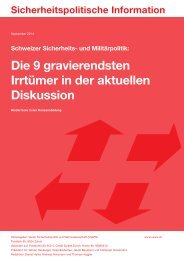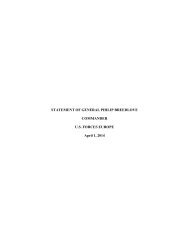FULLTEXT01
FULLTEXT01
FULLTEXT01
You also want an ePaper? Increase the reach of your titles
YUMPU automatically turns print PDFs into web optimized ePapers that Google loves.
TACTICAL THOUGHT<br />
2014 September 29 th<br />
Here, this means tactical approach which is to be expected of one’s own units. Not least,<br />
in order to be able to identify preconditions which realistically connect to strategy. Such<br />
knowledge should be sought at the operational level, in order to be able to produce<br />
practical operational art, making strategic sense in Irregular or Hybrid Warfare<br />
scenarios.<br />
Today, a commonly viewed role of operational art is to transform strategic needs to<br />
tactical missions, which are realistic to accomplish. From the tactical perspective, a task<br />
is to understand and transform tactical realities at hand, back to the strategic thinking,<br />
thus making the relational aspect of strategy and tactics alive, real and matching. Such a<br />
consequence for operational art could create a developmental need, when it comes to<br />
education of officers in Joint Warfare in Irregular or Hybrid Warfare scenarios. A<br />
combination of traditionally limited interest for Irregular Warfare in general, a limited<br />
interest in tactics in the Armed Forces, and rather dispersed tactical thinking in the<br />
officer corps, seem to be a warning sign for a strategy chosen, which requires<br />
capabilities in both Regular and Irregular Warfare. Particularly, it has to be noted that<br />
Irregular Warfare is also distinct from Regular Warfare as a way of thinking about<br />
violence in society. In Irregular Warfare, violence is not clearly separated from<br />
everyday life.<br />
This threatens as well as challenges the legal, structural, organizational structures that<br />
constitute social order. To handle challenges of this order may require further analysis<br />
by the politicians, the military and law enforcement structures, regarding rules of<br />
engagement, in order to defend social order. Seen from a military theoretical<br />
perspective, the results indicate a certain breadth and scope of tactics in land operations<br />
against an irregular opponent that currently is seldom found in normative texts or more<br />
experience-based literature. Nor has officer education equally prioritized the four<br />
relatively different tactical types presented. This construction might be the result of<br />
generations of national defence thinking, a long period of extensive operations in the<br />
Balkans and later in Afghanistan and a certain military social and cultural inheritance. If<br />
so, a question arises if it is an appropriate and wanted heritage and, if there are reasons<br />
to discuss the results relative to the education in War Studies regarding tactics-strategy<br />
in particular.<br />
This study has indicated that the ideal of Regular Warfare tactics lives on and is still<br />
thought to be the most important to be skilled in, also to such a degree that about half of<br />
the field commanders in 2011 (with rather an extensive space of experiences in Irregular<br />
Warfare tactics in the Balkans and Afghanistan during the last 20 years) position<br />
themselves mostly in thinking in Regular Warfare terms, even when the discussed<br />
scenario is quite the opposite. Still, the other half of the population clearly states tactical<br />
preference with a wider battle-environment contextualization, involving the civil<br />
dimension and non-kinetic effects. This is an example which directly knits strategy with<br />
the needs of tactical competences and resources together. If being tasked to act with<br />
military force in some sort of Irregular Warfare context that will particularly alter the<br />
environment of the civil dimension, such competences (e.g. a military police function<br />
and adapted intelligence apparatus down to low-level unit structures) might be suitable<br />
to be included earlier in conceptual thinking, education and training.<br />
116





